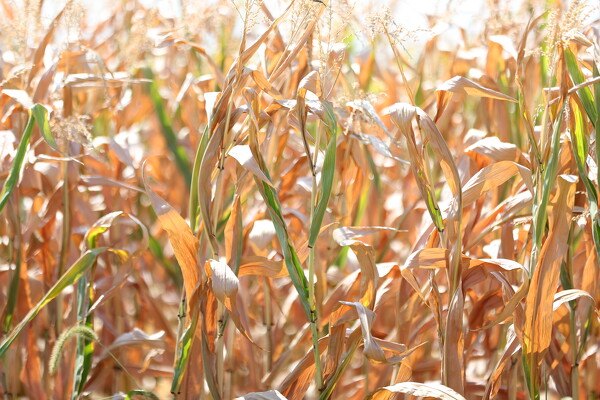Saturday, September 21st, 2024
Experts: Dry fields from drought are fire risks
From staff reports

File Photo/The Daily Standard
Above is a field of dried corn along the Mercer Auglaize County Line Road.
As Ohio grapples with its most extreme drought in years, farmers are facing an alarming rise in the risk of combine fires, experts from The Ohio State University College of Food, Agricultural, and Environmental Sciences (CFAES) warn.
The record drought, which has left 95% of the state experiencing abnormal dryness or worse, is exacerbating conditions that can easily ignite fires in dry fields, according to a news release.
The issue is especially significant this year as harvest activities are starting two to three weeks early this year due to record dry conditions, said Aaron Wilson, state climatologist and field specialist with Ohio State University Extension. OSU Extension is the outreach arm of CFAES.
"The forecast for the next week to two weeks shows few signs of significant rainfall, with perhaps some tropical moisture trying to make it into eastern Ohio midweek," Wilson said in the release. "With above-normal temperatures expected, the already dry fields will continue to lose moisture, and I expect drought conditions to worsen."
The recent stretch of hot temperatures combined with scant rainfall has resulted in 42% of Ohio in severe drought, 24% in extreme drought, and 8% in exceptional drought, according to the Sept. 12 update from the U.S. Drought Monitor.
In response to the worsening conditions, CFAES activated its Drought Rapid Response Team earlier this summer. The team, which works closely with the U.S. Department of Agriculture, state agencies, and local farmers, holds weekly check-ins to monitor weather patterns, crop health and water resources. Their goal is to assess the drought's impact and develop strategies to help farmers mitigate the effects.
Wilson said this year's drought is longer than recent ones. Southeast Ohio faced precipitation deficits before summer, which have worsened. Meanwhile, northwest Ohio has seen rapid drought development in the last 30 to 60 days, he said, noting that Ohio's drought is now being classified in several levels of severity.
"We are seeing many of our indicators, such as soil moisture, river levels, lake levels, and overall landscape impacts, hitting extreme and exceptional levels of drought," Wilson said in the release. "While extreme or exceptional drought areas have seen the driest conditions for a longer period, much of the state is still susceptible to an increased fire risk as we head into harvest."
Wilson added that the combination of low humidity, dry fields and an abundance of potential fuels means that fires can ignite easily.
"We've already seen numerous fires this week, even in areas only experiencing moderate drought," he said. "The situation is serious and likely to get worse as we move deeper into the fall."
Ohio's severe drought conditions have left crops like corn and soybeans with lower-than-usual moisture content, which further heightens the risk of fires ignited by combines.
"This year, we've had unusually dry and windy conditions, which can fuel a fire fast," said Dee Jepsen, state leader for OSU Extension's Agricultural Safety and Health Program. "In a normal year, farmers would have to dry their harvested corn and soybeans before putting them into storage."
"This year, the drought has done much of that work, but it also means farmers are dealing with highly flammable fields."
Jepsen added that farmers aren't the only ones who need to be cautious.
"It's not just farm activities. Everyday actions, such as throwing cigarette butts into ditches or burning storm debris, can spark dangerous field fires in this drought. That's why Ohio is under a burn ban," she said.
With the risk of combine fires at an all-time high, CFAES experts are offering the following critical safety advice to farmers as they head into the peak of harvest season:
• Have a daily maintenance plan during the harvest period. Blow off chaff, leaves and other plant materials regularly to reduce combustible materials. Check for faulty wiring, overheated bearings and fuel leaks.
• Farmers should attach a chain to the bottom of their combines to reduce the buildup of static electricity, which can easily ignite dry material.
• Make sure each combine is equipped with two fire extinguishers. A 10-pound ABC extinguisher should be kept in the cab, while a 20-pound extinguisher should be mounted on the outside.
Jepsen also recommended farmers consider positioning a water truck nearby to help mitigate any potential field fires.
"With remote locations and limited access, it's important to have resources at hand, especially when many rural areas rely on volunteer fire departments."
With these conditions worsening, Jepsen urged farmers to be proactive about fire preparedness.
In the event of a fire, rapid response is crucial, she added.
"Call 911 at the first sign of fire. Waiting for the fire to grow can lead to catastrophic losses, not only of machinery but also of crops and even lives."
According to data from the National Fire Incident Reporting System, Ohio ranks fourth in the nation for combine fires, a statistic that Jepsen believes could worsen this year if precautions are not taken.
"This drought is historic, and with the added challenge of a shrinking force of volunteer firefighters in rural areas, farmers must be ready to respond to fires themselves in the critical moments before help arrives," Jepsen said.
For more information, visit go.osu.edu/ohiodrought.




